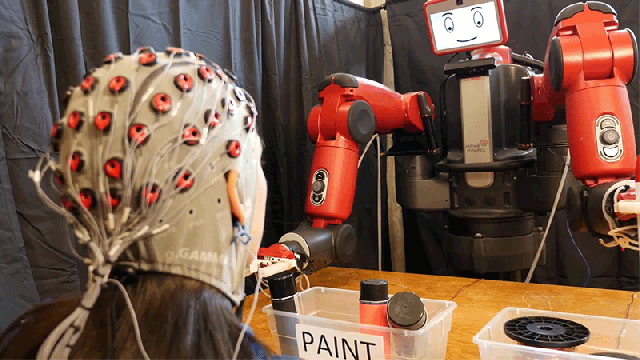Like a dog obsessively watching its owners for signs it’s a good pup, researchers at MIT’s Computer Science and Artificial Intelligence Laboratory (CSAIL) and Boston University are now using mind-mapping techniques to help train robots to perform tasks correctly.
Factory robots purpose-built for a specific task on an assembly line seldom make mistakes, but they’re expensive. Robotic factory line workers like Rethink Robotics’ Baxter are designed to be a more affordable and flexible alternative that can be taught to perform almost any repetitive task, but they come with a steeper learning curve.
To streamline the process of teaching a robot like Baxter how to properly do its job without having to constantly stop and reprogram it — or even speak a single word — the researchers at MIT’s CSAIL and Boston University created a near-instant feedback system by interfacing the robot with its human instructor’s brain.
The thought of robots being able to read our minds is undoubtedly terrifying, but this version of Baxter is only looking for a specific brainwave activity that indicates it’s made a mistake. Its instructor wears an electroencephalography (EEG) monitor on their head, and the robot monitors the real-time data stream looking for specific brain signals known as “error-related potentials” — or ErrPs, for short.
Humans instantly and subconsciously produce these ErrPs signals when the brain notices a mistake has been made. They’re faint, so the software powering Baxter has to be properly calibrated to detect them, but they make it easy for the robot to know when it’s performing an assigned task properly, with minimal human intervention. When an ErrPs signal is detected, it also allows the robot to make a behavioural correction in as little as 10 milliseconds, barely interrupting its workflow.
As the researchers work to improve the robot’s mind-mapping software, they are confident it can achieve upwards of 90 per cent accuracy, greatly reducing the time it takes to teach one of these bots a new task. As for the other 10 per cent of the time when the robot isn’t sure if it’s screwed up, it can simply stop and ask its instructor if it’s doing things right, rather than just going ahead and making a huge mistake that could be expensive and time-consuming to fix.
[MIT News]
